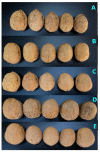Comparative Study on the Volatile Organic Compounds and Characteristic Flavor Fingerprints of Five Varieties of Walnut Oil in Northwest China Using Using Headspace Gas Chromatography-Ion Mobility Spectrometry
- PMID: 37049712
- PMCID: PMC10096422
- DOI: 10.3390/molecules28072949
Comparative Study on the Volatile Organic Compounds and Characteristic Flavor Fingerprints of Five Varieties of Walnut Oil in Northwest China Using Using Headspace Gas Chromatography-Ion Mobility Spectrometry
Abstract
Odor is an important characteristic of walnut oil; walnut oil aromas from different varieties smell differently. In order to compare the differences of volatile flavor characteristics in different varieties of walnut oil, the volatile organic compounds (VOCs) of walnut oil from five different walnut varieties in Northwest China were detected and analyzed using headspace gas chromatography-ion mobility spectrometry (HS-GC-IMS). The results showed that 41 VOCs in total were identified in walnut oil from five different varieties, including 14 aldehydes, 8 alcohols, 4 ketones, and 2 esters. Walnut oil (WO) extracted from the "Zha343" variety was most abundant in VOCs. The relative odor activity value (ROAV) analysis showed that aldehydes were the main aroma substances of walnut oil; specifically, hexanal, pentanal, and heptanal were the most abundant. Fingerprints and heat map analysis indicated that WO extracted from the "Xin2", "185", "Xin'guang", and "Zha343" varieties, but not from the "Xinfeng" variety, had characteristic markers. The relative content differences of eight key VOCs in WO from five varieties can be directly compared by Kruskal-Wallis tests, among which the distribution four substances, hexanal (M), hexanal (D), pentanal (M), (E)-2-hexanal (M), presented extremely significant differences (P<0.01). According to the results of the principal component analysis (PCA), WO extracted from the "Zha343" variety was distinct from the other four varieties; in addition, WO extracted from the "Xin2" variety exhibited similarity to WO extracted from the "185" variety, and WO extracted from the "Xinfeng" variety showed similarity to WO extracted from the "Xin'guang" variety. These results reveal that there are certain differences in the VOCs extracted from five different WO varieties, making it feasible to distinguish different varieties of walnut oil or to rapidly detect walnut oil quality based on its volatile substances profile.
Keywords: HS–GC–IMS; flavor fingerprint; volatile organic compounds; walnut oil.
Conflict of interest statement
The authors declare no conflict of interest.
Figures






Similar articles
-
Characterization and metabolism pathway of volatile compounds in walnut oil obtained from various ripening stages via HS-GC-IMS and HS-SPME-GC-MS.Food Chem. 2024 Mar 1;435:137547. doi: 10.1016/j.foodchem.2023.137547. Epub 2023 Sep 21. Food Chem. 2024. PMID: 37769558
-
Dynamic changes in volatile organic compounds of cherry tomato fruits during storage at different temperatures using HS-GC-IMS.Food Res Int. 2025 Oct;218:116790. doi: 10.1016/j.foodres.2025.116790. Epub 2025 Jun 12. Food Res Int. 2025. PMID: 40790653
-
Comparison of aroma active compounds in cold- and hot-pressed walnut oil by comprehensive two-dimensional gas chromatography-olfactory-mass spectrometry and headspace-gas chromatography-ion mobility spectrometry.Food Res Int. 2023 Jan;163:112208. doi: 10.1016/j.foodres.2022.112208. Epub 2022 Nov 19. Food Res Int. 2023. PMID: 36596141
-
Gas chromatography-ion mobility spectrometry (GC-IMS) technique and its recent applications in grain research.J Sci Food Agric. 2024 Dec;104(15):9093-9101. doi: 10.1002/jsfa.13622. Epub 2024 May 31. J Sci Food Agric. 2024. PMID: 38817147 Review.
-
Sniffing Out Urinary Tract Infection-Diagnosis Based on Volatile Organic Compounds and Smell Profile.Biosensors (Basel). 2020 Jul 23;10(8):83. doi: 10.3390/bios10080083. Biosensors (Basel). 2020. PMID: 32717983 Free PMC article. Review.
Cited by
-
Analysis of VOCs in Liquids through Vaporization in a Tubular Oven Monitored by Chemical Ionization Mass Spectrometry.Sensors (Basel). 2024 Feb 6;24(4):1048. doi: 10.3390/s24041048. Sensors (Basel). 2024. PMID: 38400206 Free PMC article.
-
Analysis of the Differences in Volatile Organic Compounds in Different Rice Varieties Based on GC-IMS Technology Combined with Multivariate Statistical Modelling.Molecules. 2023 Nov 13;28(22):7566. doi: 10.3390/molecules28227566. Molecules. 2023. PMID: 38005287 Free PMC article.
-
Perceptual Effects of Walnut Volatiles on the Codling Moth.Insects. 2024 May 30;15(6):402. doi: 10.3390/insects15060402. Insects. 2024. PMID: 38921117 Free PMC article.
References
-
- Martínez M.L., Penci M.C., Ixtaina V., Ribotta P.D., Maestri D. Effect of natural and synthetic antioxidants on the oxidative stability of walnut oil under different storage conditions. LWT Food Sci. Technol. 2013;51:44–50. doi: 10.1016/j.lwt.2012.10.021. - DOI
-
- Uzma N.S., Mir J.I., Ahmed N., Khalid M.F. Assessment of germplasm diversity and genetic relationships among walnut (Juglans regia L.) genotypes through microsatellite markers. J. Saudi Soc. Agric. Sci. 2018;17:339–350.
-
- Calvo P., Lozano M., Espinosa-Mansilla A., González-Gómez D. In-vitro evaluation of the availability of ϖ-3 and ϖ-6 fatty acids and tocopherols from microencapsulated walnut oil. Food Res. Int. 2012;48:316–321. doi: 10.1016/j.foodres.2012.05.007. - DOI
-
- Sun H., Xu J., Lu X.Z., Xu Y.Y., Joe M.R., Zhang Y., Wang F.J. Development and characterization of monoglyceride oleogels prepared with crude and refined walnut oil—ScienceDirect. LWT Food Sci. Technol. 2022;154:112769. doi: 10.1016/j.lwt.2021.112769. - DOI
MeSH terms
Substances
Grants and funding
LinkOut - more resources
Full Text Sources
Miscellaneous

